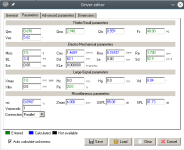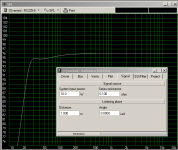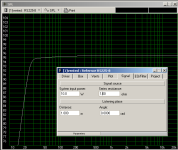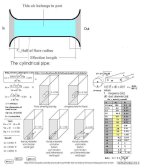I haven't built anything yet so still a paper exercise. Couple of things I have noticed. Max power and max spl graphs never show anything. Is this normal? Then ...........
At times cone excursion and the 2 transfer functions in the same block of options (magnitude and phase) do the same thing. I can only get them to function again by reloading the project.
I'm trying to come up with a woofer to go with 2 existing speakers so I looked at adding series resistance in case the woofer spl is too high. It has this effect
I appreciate appreciate adding R alter the Q's but the change 1ohm makes to spl may not be enough. Increase that and the graphs mentioned go blank at some point. The other factor is that adding R changes cone excursion as well - in a beneficial way. Those 2 shots were taken with those particular graph's showing nothing. So all of the others remain ok.
I'm a bit bemused as to why this happens and if there is a fix.
At times cone excursion and the 2 transfer functions in the same block of options (magnitude and phase) do the same thing. I can only get them to function again by reloading the project.
I'm trying to come up with a woofer to go with 2 existing speakers so I looked at adding series resistance in case the woofer spl is too high. It has this effect
I appreciate appreciate adding R alter the Q's but the change 1ohm makes to spl may not be enough. Increase that and the graphs mentioned go blank at some point. The other factor is that adding R changes cone excursion as well - in a beneficial way. Those 2 shots were taken with those particular graph's showing nothing. So all of the others remain ok.
I'm a bit bemused as to why this happens and if there is a fix.
Attachments
You probably don't have all the driver parameters entered. Make sure the "Xmax" and "Pe" parameters have been entered.
😉 Nail on the head but hang on. I take it that if I click on the edit button on the main screen and select parameters those relate to the speaker? Pe - not mentioned on the speaker data sheet what is it?
Anyway parameters shows all fields as blanks - or does now. The X max etc did work correctly when I noticed the adding a resistor effects and and spl still does with and without the resistor. Xmax is now blank. It did show the red line.
I set it all up following a tutorial that points out the order the speaker parameters have to be entered so that it calculates some correctly itself. Changing the box volume and tuning the port took several reloads of the project and saves. Vent velocity ok etc and then looked at Xmax. 🙁 It will need a subsonic filter. Then added the resistor. Still ok until Xmax went awol with a higher value R. A a quit andreload did work but doesn't now.
I'm running it under wine on Linux and have also used a different project directory than the default one. It's been set up like that right from the start.
I assume I can re enter the speaker parameters via the edit function but have to wonder how they disappeared or if they ever got there. I used start a new project initially.
Anyway parameters shows all fields as blanks - or does now. The X max etc did work correctly when I noticed the adding a resistor effects and and spl still does with and without the resistor. Xmax is now blank. It did show the red line.
I set it all up following a tutorial that points out the order the speaker parameters have to be entered so that it calculates some correctly itself. Changing the box volume and tuning the port took several reloads of the project and saves. Vent velocity ok etc and then looked at Xmax. 🙁 It will need a subsonic filter. Then added the resistor. Still ok until Xmax went awol with a higher value R. A a quit andreload did work but doesn't now.
I'm running it under wine on Linux and have also used a different project directory than the default one. It's been set up like that right from the start.
I assume I can re enter the speaker parameters via the edit function but have to wonder how they disappeared or if they ever got there. I used start a new project initially.
Within an existing project: the driver, edit function creates a version of the driver parameters unique to that project only. If you create a new project using the same driver you won’t see the changed parameters. To permanently change a driver’s parameters I use the driver editor (the little loudspeaker in the menu bar or Alt-D in Windows). Load the driver, change the parameter(s) and save it. All new projects using the driver will have the updated parameters.
Thanks, Couple of other questions if anyone can answer. My problem I mnetioned may have been using different directories for projects and speaker files In fact may have not made one for speakers just entered data via new project, It was ok for a while though.
Entering speaker data in a certain order, Is this really needed? I find it surprising that some one would produce code like that unless it's left to right top to bottom or calc when all have been entered.
Two versions are around 0.5... and 0.7..... Which to use and why? Any known problems or advantages with either? Both appear to be used. I expect some mods may be needed once a design has been built.
Opinions may vary. OK with me,
One for any package where the port is adjusted. I would be using an essentially square port rather than a slot. No flare. Should this use a specific end correction factor? To me that sounds as if it will be a better option than a rather elongated slot but may be wrong.
Entering speaker data in a certain order, Is this really needed? I find it surprising that some one would produce code like that unless it's left to right top to bottom or calc when all have been entered.
Two versions are around 0.5... and 0.7..... Which to use and why? Any known problems or advantages with either? Both appear to be used. I expect some mods may be needed once a design has been built.
Opinions may vary. OK with me,
One for any package where the port is adjusted. I would be using an essentially square port rather than a slot. No flare. Should this use a specific end correction factor? To me that sounds as if it will be a better option than a rather elongated slot but may be wrong.
Not a problem, I have it installed in the 'Downloads' folder.
Yes, study T/S theory, math to see why:
00Thiele / Small parameters explained with real world cases
00Thiele Small parameters equations - How each one affects the others
0.7 resolved many 'issues', but for serious/most accurate (freeware) designing, best to use Hornresp and yes, sometimes need tweaking 'in situ', especially WRT vent tuning, though most times using the pioneer's 'click' test to critically damp it is sufficient.
Convert square to round i.d. to find its basic end correction. Attached is currently the most accurate port chart.
Yes, study T/S theory, math to see why:
00Thiele / Small parameters explained with real world cases
00Thiele Small parameters equations - How each one affects the others
0.7 resolved many 'issues', but for serious/most accurate (freeware) designing, best to use Hornresp and yes, sometimes need tweaking 'in situ', especially WRT vent tuning, though most times using the pioneer's 'click' test to critically damp it is sufficient.
Convert square to round i.d. to find its basic end correction. Attached is currently the most accurate port chart.
Attachments
I have it installed on C: but the speaker spec's and project file arn't. These are not in it's default folders for these. (Under wine on linux). Doing this doesn't usually cause problems with other apps that run under wine. It may in this ones case,I have it installed in the 'Downloads' folder.
Just following comments but need to check the app calculates a couple of number that are not give in speaker specs.Yes, study T/S theory, math to see why:
Last edited:
OK, FWIW, all my speaker design programs are in their own sub folders in 'Downloads' with nary a problem with any in Win7pro, but I do have to be careful with any updates as some auto load elsewhere on 'C' drive, which IME can make a mess when trying to use the program without moving the updates to the right folder.
Right, some specs must be calculated to do certain advanced response plots, but been so long since I've used it I can't recall them.
Right, some specs must be calculated to do certain advanced response plots, but been so long since I've used it I can't recall them.

It gets better 🙁. On 0.7... Entering speaker parameters does as I thought, some extra values calculated. I just put them in left to right top to bottom and then saved. I can try changing the order. Tried a project and wow got a -3db at sub 20hz with a -3db shelf. Higher number than I'd choose. A system wide search showed that the speaker file hadn't been saved. It used the first one in it's own list.
If I search RS225-8 different result. 0.5 created a project and a speaker file in the wine drive. O.7 just the speaker file. Wine drive is effectively a windows C drive and both apps create a linearteam directory in program files x86. It also stores stuff in users/john/mydocs on the c drive. Stuff in drive files, nothing in projects. The driver section same content as the linearteam directory's one.
As both versions use the linearteam directory looks like both can't be installed at the same time. Most app devs would use a different directory for each version - or should. I have had both installed but removed one. That may be why it acted up.
I tried new project using 0.7.. and to load the driver data navigated to the linearteam directory. It immediately loaded the only one I had added with 0.5... 😉 It might give a selection if more than one.
Then I did what I did before - increased the input series resistance to 2ohms. The plots in the Xmax group stopped working and wont come back even when 0.1 ohms is set again. 25w SPL dropped a bit and that still responds to the resistance value entered. The value can be increased, not sure by how much.
Odd thing about the driver editor. It lacks a button that would be marked use. All it can do is save so a new project is needed to set the data. Ok now I know I can load a selected speaker via that.
If I search RS225-8 different result. 0.5 created a project and a speaker file in the wine drive. O.7 just the speaker file. Wine drive is effectively a windows C drive and both apps create a linearteam directory in program files x86. It also stores stuff in users/john/mydocs on the c drive. Stuff in drive files, nothing in projects. The driver section same content as the linearteam directory's one.
As both versions use the linearteam directory looks like both can't be installed at the same time. Most app devs would use a different directory for each version - or should. I have had both installed but removed one. That may be why it acted up.
I tried new project using 0.7.. and to load the driver data navigated to the linearteam directory. It immediately loaded the only one I had added with 0.5... 😉 It might give a selection if more than one.
Then I did what I did before - increased the input series resistance to 2ohms. The plots in the Xmax group stopped working and wont come back even when 0.1 ohms is set again. 25w SPL dropped a bit and that still responds to the resistance value entered. The value can be increased, not sure by how much.
Odd thing about the driver editor. It lacks a button that would be marked use. All it can do is save so a new project is needed to set the data. Ok now I know I can load a selected speaker via that.
Interesting! Admittedly my comment was based on the users' responses from back when it debuted; guess I need to find some time to load and play with it since all I remember now is that WinISD Pro alpha was a 'dream' to use and led to believe 0.5 was even better except for some glitches that 0.7 fixed.
Bit misleading. What I meant is it's not possible to see the speaker data that is being used other than by loading it again and cancelling.new project is needed to set the data
I've been following a tutorial by midwest audio. It mentions that on 0.5.. the provided speaker database files can be deleted. 😉 0.7... isn't happy about that. The tutorial states a certain order to enter the data. Looks like that is needed and appeared to be ok with the data order given by Dayton. Maybe not with Visaton. Visaton don't state Vas so I assumed that Mms and BL had to be entered. That caused Vas to be calculated. The display maybe not as clear as 0.5.....

The html help file also states an order for entry
The suggested procedure for entering driver parameters is following (check first that "Auto calculate unknowns" option is checked):
1. Enter Mms and Cms
This gives fs. If either is not available, then enter fs and other parameter.
2. Enter Sd, Bl and Re
Now, you should get all but Qms (and Qts), Vas. Please note that Vas may not match exactly what is specified by manufacturer, because exact value of Vas depends on environmental parameters. See FAQ. 3. Enter Rms or Qms.
Either one will do, although I tend to prefer Qms over Rms, because it can usually be measured in driver measurement procedures.
4. Enter Hc, Hg and Pe.
If Hc or Hg or either is available, then enter Xmax and optionally either Hc or Hg if available.
5. Enter number of voicecoils.
This procedure is most accurate. Also note that it also calculates true SPL (1W/1m) value. So it might not match the marketing SPL value, which is generally somewhat vague. Not in all cases, though.
😉 So I'll try that also reinstall to get their speaker files back. Need to start them with a or aaa etc to get to the top of the list.
One thing that bugs me somewhat. To use materials I have kicking about I am going to try PC speakers. SPL levels looks like I would only be running them at a couple of watts. I've no feel for this at all. 1w appears to give 81db at 1m.
Results so far F3 at 32hz but box too big really and if I add a sub I could use a bigger speaker. Makers claim usable to 35Hz
- Home
- Design & Build
- Software Tools
- WinISD Pro query



